wheel YAMAHA JOG50R 2012 Owners Manual
[x] Cancel search | Manufacturer: YAMAHA, Model Year: 2012, Model line: JOG50R, Model: YAMAHA JOG50R 2012Pages: 76, PDF Size: 1.51 MB
Page 6 of 76
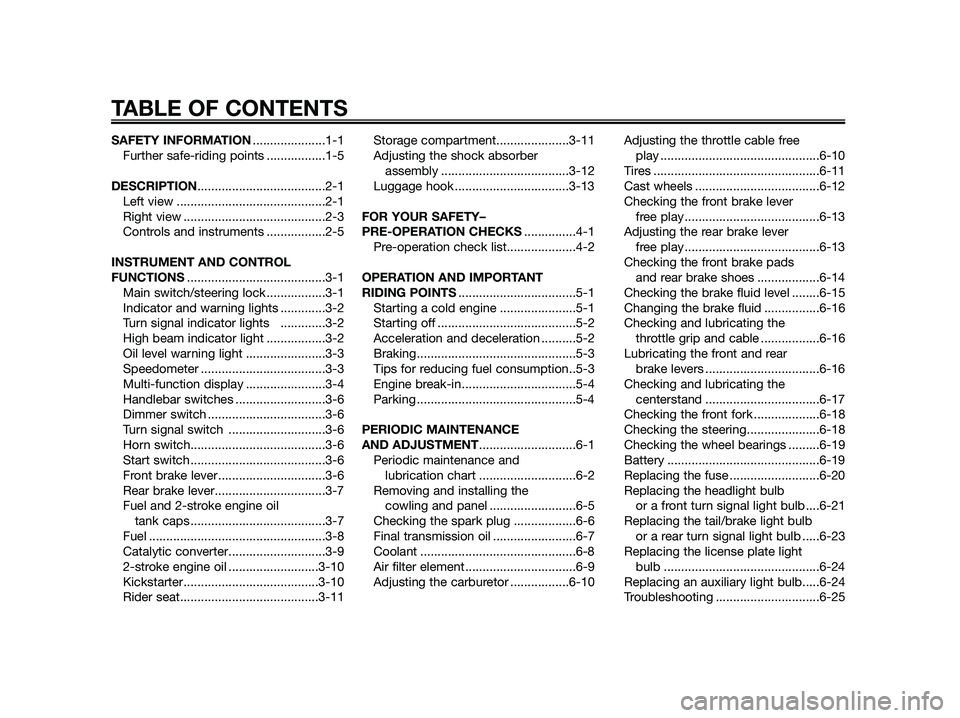
SAFETY INFORMATION.....................1-1
Further safe-riding points .................1-5
DESCRIPTION.....................................2-1
Left view ...........................................2-1
Right view .........................................2-3
Controls and instruments .................2-5
INSTRUMENT AND CONTROL
FUNCTIONS........................................3-1
Main switch/steering lock .................3-1
Indicator and warning lights .............3-2
Turn signal indicator lights .............3-2
High beam indicator light .................3-2
Oil level warning light .......................3-3
Speedometer ....................................3-3
Multi-function display .......................3-4
Handlebar switches ..........................3-6
Dimmer switch ..................................3-6
Turn signal switch ............................3-6
Horn switch.......................................3-6
Start switch .......................................3-6
Front brake lever...............................3-6
Rear brake lever................................3-7
Fuel and 2-stroke engine oil
tank caps .......................................3-7
Fuel ...................................................3-8
Catalytic converter............................3-9
2-stroke engine oil ..........................3-10
Kickstarter.......................................3-10
Rider seat........................................3-11Storage compartment.....................3-11
Adjusting the shock absorber
assembly .....................................3-12
Luggage hook .................................3-13
FOR YOUR SAFETY–
PRE-OPERATION CHECKS...............4-1
Pre-operation check list....................4-2
OPERATION AND IMPORTANT
RIDING POINTS..................................5-1
Starting a cold engine ......................5-1
Starting off ........................................5-2
Acceleration and deceleration ..........5-2
Braking..............................................5-3
Tips for reducing fuel consumption..5-3
Engine break-in.................................5-4
Parking ..............................................5-4
PERIODIC MAINTENANCE
AND ADJUSTMENT............................6-1
Periodic maintenance and
lubrication chart ............................6-2
Removing and installing the
cowling and panel .........................6-5
Checking the spark plug ..................6-6
Final transmission oil ........................6-7
Coolant .............................................6-8
Air filter element ................................6-9
Adjusting the carburetor .................6-10Adjusting the throttle cable free
play ..............................................6-10
Tires ................................................6-11
Cast wheels ....................................6-12
Checking the front brake lever
free play .......................................6-13
Adjusting the rear brake lever
free play .......................................6-13
Checking the front brake pads
and rear brake shoes ..................6-14
Checking the brake fluid level ........6-15
Changing the brake fluid ................6-16
Checking and lubricating the
throttle grip and cable .................6-16
Lubricating the front and rear
brake levers .................................6-16
Checking and lubricating the
centerstand .................................6-17
Checking the front fork ...................6-18
Checking the steering.....................6-18
Checking the wheel bearings .........6-19
Battery ............................................6-19
Replacing the fuse ..........................6-20
Replacing the headlight bulb
or a front turn signal light bulb ....6-21
Replacing the tail/brake light bulb
or a rear turn signal light bulb .....6-23
Replacing the license plate light
bulb .............................................6-24
Replacing an auxiliary light bulb.....6-24
Troubleshooting ..............................6-25
TABLE OF CONTENTS
Page 9 of 76

cornering (insufficient lean angle
for the speed).
• Always obey the speed limit
and never travel faster than
warranted by road and traffic
conditions.
• Always signal before turning or
changing lanes. Make sure that
other motorists can see you.
●The posture of the operator and
passenger is important for proper
control.
• The operator should keep both
hands on the handlebar and
both feet on the operator foo-
trests during operation to
maintain control of the scooter.
• The passenger should always
hold onto the operator, the seat
strap or grab bar, if equipped,
with both hands and keep both
feet on the passenger foo-
trests. Never carry a passenger
unless he or she can firmly pla-
ce both feet on the passenger
footrests.
●Never ride under the influence of
alcohol or other drugs.
●This scooter is designed for on-road use only. It is not suitable for
off-road use.
Protective apparel
The majority of fatalities from scooter
accidents are the result of head inju-
ries. The use of a safety helmet is the
single most critical factor in the pre-
vention or reduction of head injuries.
●Always wear an approved hel-
met.
●Wear a face shield or goggles.
Wind in your unprotected eyes
could contribute to an impair-
ment of vision that could delay
seeing a hazard.
●The use of a jacket, substantial
shoes, trousers, gloves, etc., is
effective in preventing or redu-
cing abrasions or lacerations.
●Never wear loose-fitting clothes,
otherwise they could catch on
the control levers or wheels and
cause injury or an accident.
●Always wear protective clothing
that covers your legs, ankles, and
feet. The engine or exhaust sys-
tem become very hot during or
after operation and can cause
burns.
●A passenger should also observe
the above precautions.
Avoid Carbon Monoxide Poisoning
All engine exhaust contains carbon
monoxide, a deadly gas. Breathing
carbon monoxide can cause heada-
ches, dizziness, drowsiness, nausea,
confusion, and eventually death.
Carbon Monoxide is a colorless,
odorless, tasteless gas which may be
present even if you do not see or
smell any engine exhaust. Deadly
levels of carbon monoxide can collect
rapidly and you can quickly be over-
come and unable to save yourself.
Also, deadly levels of carbon monoxi-
de can linger for hours or days in
enclosed or poorly ventilated areas. If
you experience any symptoms of car-
bon monoxide poisoning, leave the
area immediately, get fresh air, and
SEEK MEDICAL TREATMENT.
1
SAFETY INFORMATION
1-2
Page 32 of 76

FOR YOUR SAFETY – PRE-OPERATION CHECKS
4-2
4
EAU15605
Pre-operation check list
ITEM CHECKS PAGE
• Check fuel level in fuel tank.
Fuel• Refuel if necessary.3-8
• Check fuel line for leakage.
• Check oil level in oil tank.
2-stroke engine oil• If necessary, add recommended oil to specified level. 3-10
• Check vehicle for oil leakage.
Final transmission oil• Check vehicle for oil leakage. 6-7
• Check coolant level in reservoir.
Coolant (CS50Z)• If necessary, add recommended coolant to specified level. 6-8
• Check cooling system for leakage.
• Check operation.
• If soft or spongy, have Yamaha dealer bleed hydraulic system.
• Check brake pads for wear.
Front brake• Replace if necessary. 6-13, 6-14, 6-15
• Check fluid level in reservoir.
• If necessary, add recommended brake fluid to specified level.
• Check hydraulic system for leakage.
• Check operation.
Rear brake• Lubricate cable if necessary.
• Check lever free play.6-13, 6-14
• Adjust if necessary.
• Make sure that operation is smooth.
Throttle grip• Check cable free play.
• If necessary, have Yamaha dealer adjust cable free play 6-10, 6-16
and lubricate cable and grip housing.
• Check for damage.
Wheels and tires• Check tire condition and tread depth.
• Check air pressure.6-11, 6-12
• Correct if necessary.
Page 40 of 76
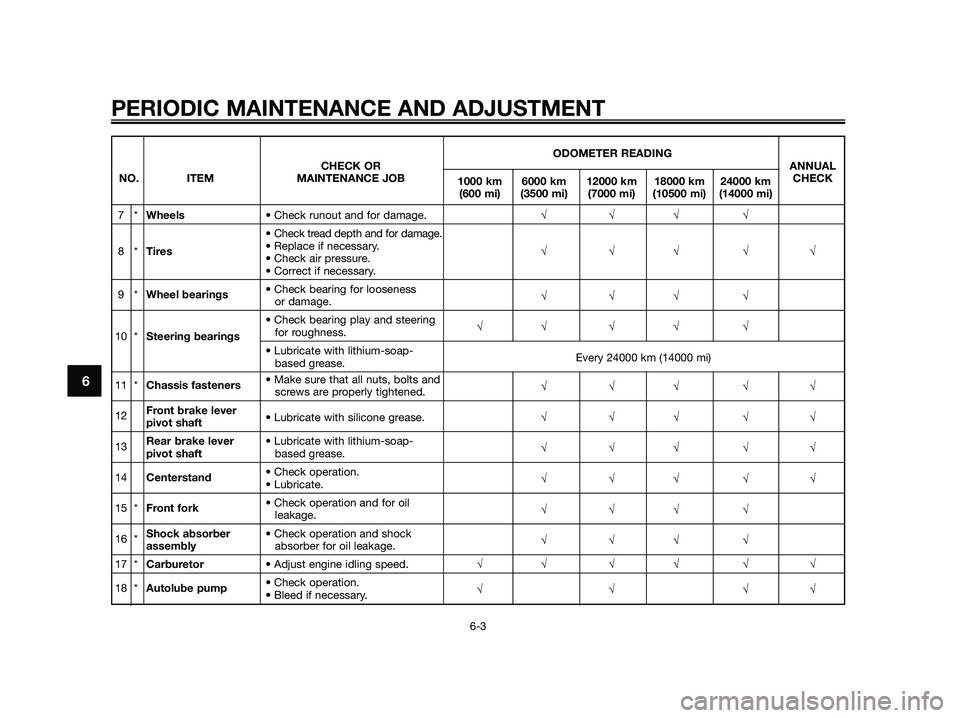
PERIODIC MAINTENANCE AND ADJUSTMENT
6-3
6
ODOMETER READING
CHECK OR ANNUAL
NO. ITEM MAINTENANCE JOB
1000 km 6000 km 12000 km 18000 km 24000 kmCHECK
(600 mi) (3500 mi) (7000 mi) (10500 mi) (14000 mi)
7*Wheels• Check runout and for damage.√√√ √
• Check tread depth and for damage.
8*Tires• Replace if necessary.
√√√ √√
• Check air pressure.
• Correct if necessary.
9*Wheel bearings• Check bearing for looseness
or damage.√√√ √
• Check bearing play and steering
10 *Steering bearingsfor roughness.√√ √√ √
• Lubricate with lithium-soap-
based grease.Every 24000 km (14000 mi)
11 *Chassis fasteners• Make sure that all nuts, bolts and
screws are properly tightened.√√√ √√
12Front brake lever
pivot shaft• Lubricate with silicone grease.√√√ √√
13Rear brake lever • Lubricate with lithium-soap-
pivot shaftbased grease.√√√ √√
14Centerstand• Check operation.
• Lubricate.√√√ √√
15 *Front fork• Check operation and for oil
leakage.√√√ √
16 *Shock absorber • Check operation and shock
assemblyabsorber for oil leakage.√√√ √
17 *Carburetor• Adjust engine idling speed.√√ √√ √ √
18 *Autolube pump• Check operation.
• Bleed if necessary.√√ √√
Page 45 of 76

6. Refill with the specified amount
of the recommended final trans-
mission oil, and then install and
tighten the oil filler cap. WAR-
NING! Make sure that no
foreign material enters the final
transmission case. Make sure
that no oil gets on the tire or
wheel.
[EWA11311]
7. Check the final transmission case
for oil leakage. If oil is leaking,
check for the cause.
EAUS1200
Coolant (CS50Z)
The coolant level should be checked
before each ride. In addition, the coo-
lant must be changed at the intervals
specified in the periodic maintenance
and lubrication chart.
EAUM2102
To check the coolant level
1. Place the vehicle on a level surfa-
ce and hold it in an upright posi-
tion.
TIP
●The coolant level must be chec-
ked on a cold engine since the
level varies with engine tempera-
ture.
●Make sure that the vehicle is
positioned straight up when
checking the coolant level. A
slight tilt to the side can result in
a false reading.
2. Check the coolant level through
the check window.
TIP
The coolant should be between the
minimum and maximum level marks.
1. Coolant level check window
2. Maximum level mark
3. Minimum level mark
3. If the coolant is at or below the
minimum level mark, remove the
cowling A. (See page 6-5).
4. Open the reservoir cap, and then
add coolant to the maximum
level mark. WARNING! Remove
only the coolant reservoir cap.
Never attempt to remove the
radiator cap when the engine is
hot.
[EWA15161]. NOTICE: If coolant
is not available, use distilled
MAX
MIN2
3
1
Recommended final transmission
oil:
See page 8-1
Oil quantity:
0.11 L (0.12 US qt, 0.10 Imp.qt)
Tightening torque:
Final transmission oil drain bolt:
18 Nm (1.8 m•kgf, 13.0 ft•lbf)
PERIODIC MAINTENANCE AND ADJUSTMENT
6-8
6
Page 49 of 76
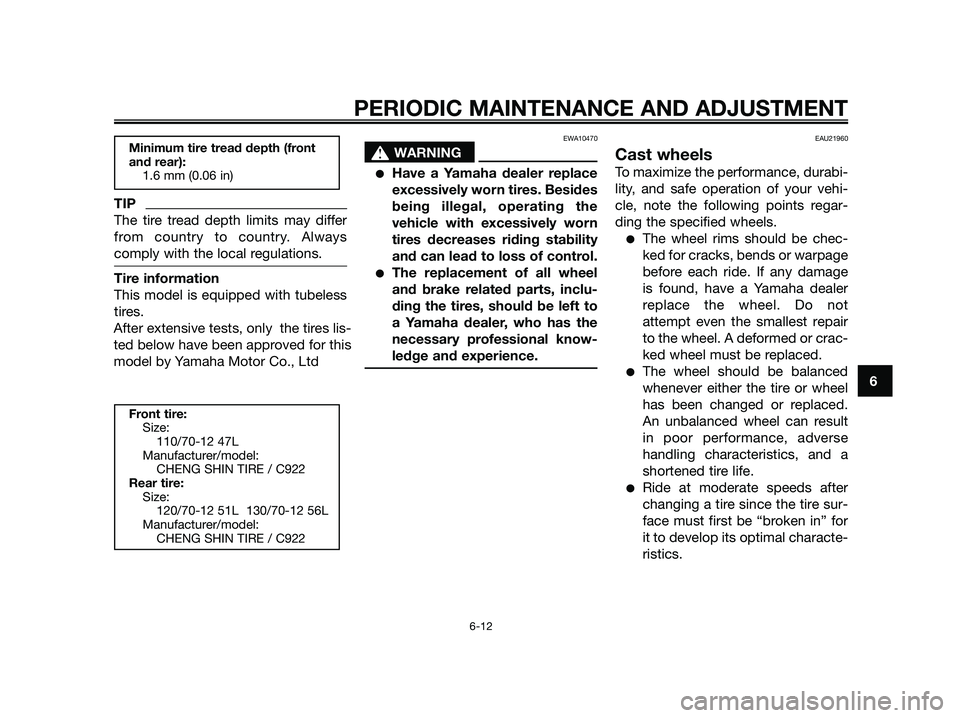
TIP
The tire tread depth limits may differ
from country to country. Always
comply with the local regulations.
Tire information
This model is equipped with tubeless
tires.
After extensive tests, only the tires lis-
ted below have been approved for
this model by Yamaha Motor España,
S.A.
EWA10470
sWARNING
●Have a Yamaha dealer replace
excessively worn tires. Besides
being illegal, operating the
vehicle with excessively worn
tires decreases riding stability
and can lead to loss of control.
●The replacement of all wheel
and brake related parts, inclu-
ding the tires, should be left to
a Yamaha dealer, who has the
necessary professional know-
ledge and experience.
EAU21960
Cast wheels
To maximize the performance, durabi-
lity, and safe operation of your vehi-
cle, note the following points regar-
ding the specified wheels.
●The wheel rims should be chec-
ked for cracks, bends or warpage
before each ride. If any damage
is found, have a Yamaha dealer
replace the wheel. Do not
attempt even the smallest repair
to the wheel. A deformed or crac-
ked wheel must be replaced.
●The wheel should be balanced
whenever either the tire or wheel
has been changed or replaced.
An unbalanced wheel can result
in poor performance, adverse
handling characteristics, and a
shortened tire life.
●Ride at moderate speeds after
changing a tire since the tire sur-
face must first be “broken in” for
it to develop its optimal characte-
ristics.
Front tire:
Size:
110/70-12 47L
Manufacturer/model:
CHENG SHIN TIRE / C922
Rear tire:
Size:
120/70-12 51L 130/70-12 56L
Manufacturer/model:
CHENG SHIN TIRE / C922
Minimum tire tread depth (front
and rear):
1.6 mm (0.06 in)
PERIODIC MAINTENANCE AND ADJUSTMENT
6-12
6
After extensive tests, only the tires lis-
ted below have been approved for this
model by Yamaha Motor Co., Ltd
Page 56 of 76
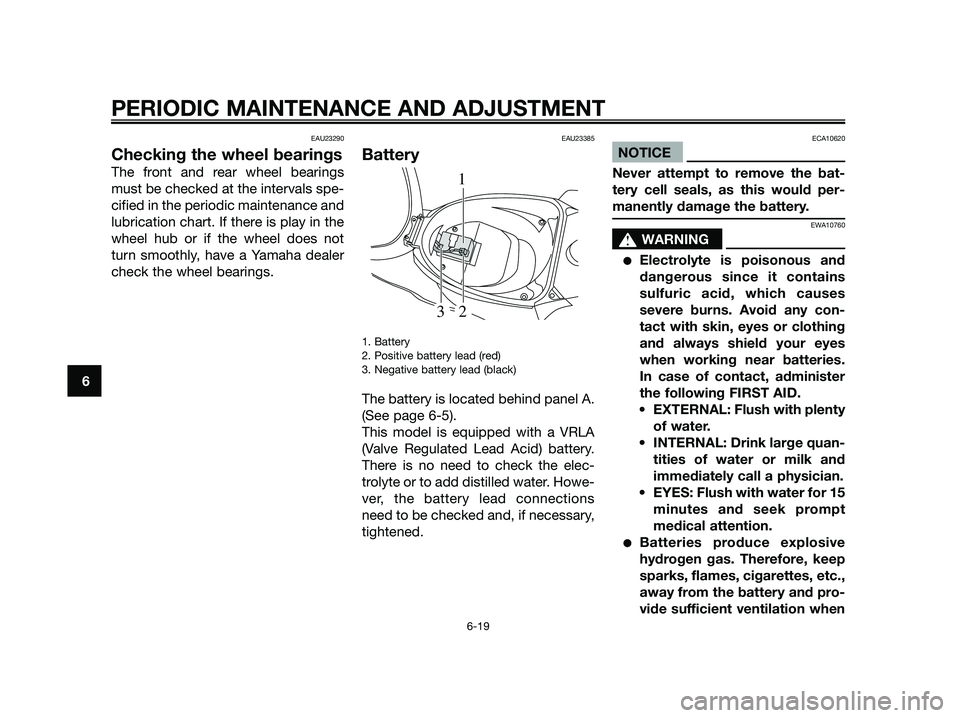
EAU23290
Checking the wheel bearings
The front and rear wheel bearings
must be checked at the intervals spe-
cified in the periodic maintenance and
lubrication chart. If there is play in the
wheel hub or if the wheel does not
turn smoothly, have a Yamaha dealer
check the wheel bearings.
EAU23385
Battery
1. Battery
2. Positive battery lead (red)
3. Negative battery lead (black)
The battery is located behind panel A.
(See page 6-5).
This model is equipped with a VRLA
(Valve Regulated Lead Acid) battery.
There is no need to check the elec-
trolyte or to add distilled water. Howe-
ver, the battery lead connections
need to be checked and, if necessary,
tightened.
ECA10620
NOTICE
Never attempt to remove the bat-
tery cell seals, as this would per-
manently damage the battery.
EWA10760
sWARNING
●Electrolyte is poisonous and
dangerous since it contains
sulfuric acid, which causes
severe burns. Avoid any con-
tact with skin, eyes or clothing
and always shield your eyes
when working near batteries.
In case of contact, administer
the following FIRST AID.
• EXTERNAL: Flush with plenty
of water.
• INTERNAL: Drink large quan-
tities of water or milk and
immediately call a physician.
• EYES: Flush with water for 15
minutes and seek prompt
medical attention.
●Batteries produce explosive
hydrogen gas. Therefore, keep
sparks, flames, cigarettes, etc.,
away from the battery and pro-
vide sufficient ventilation when
1
23
PERIODIC MAINTENANCE AND ADJUSTMENT
6-19
6
Page 65 of 76
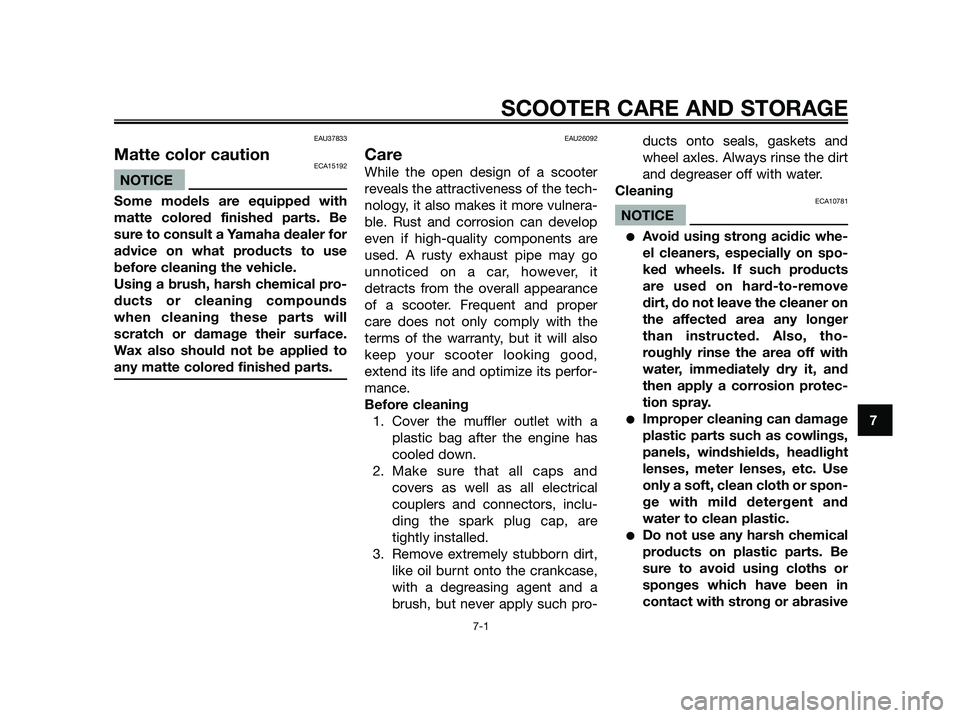
EAU37833
Matte color cautionECA15192
NOTICE
Some models are equipped with
matte colored finished parts. Be
sure to consult a Yamaha dealer for
advice on what products to use
before cleaning the vehicle.
Using a brush, harsh chemical pro-
ducts or cleaning compounds
when cleaning these parts will
scratch or damage their surface.
Wax also should not be applied to
any matte colored finished parts.
EAU26092
Care
While the open design of a scooter
reveals the attractiveness of the tech-
nology, it also makes it more vulnera-
ble. Rust and corrosion can develop
even if high-quality components are
used. A rusty exhaust pipe may go
unnoticed on a car, however, it
detracts from the overall appearance
of a scooter. Frequent and proper
care does not only comply with the
terms of the warranty, but it will also
keep your scooter looking good,
extend its life and optimize its perfor-
mance.
Before cleaning
1. Cover the muffler outlet with a
plastic bag after the engine has
cooled down.
2. Make sure that all caps and
covers as well as all electrical
couplers and connectors, inclu-
ding the spark plug cap, are
tightly installed.
3. Remove extremely stubborn dirt,
like oil burnt onto the crankcase,
with a degreasing agent and a
brush, but never apply such pro-ducts onto seals, gaskets and
wheel axles. Always rinse the dirt
and degreaser off with water.
Cleaning
ECA10781
NOTICE
●Avoid using strong acidic whe-
el cleaners, especially on spo-
ked wheels. If such products
are used on hard-to-remove
dirt, do not leave the cleaner on
the affected area any longer
than instructed. Also, tho-
roughly rinse the area off with
water, immediately dry it, and
then apply a corrosion protec-
tion spray.
●Improper cleaning can damage
plastic parts such as cowlings,
panels, windshields, headlight
lenses, meter lenses, etc. Use
only a soft, clean cloth or spon-
ge with mild detergent and
water to clean plastic.
●Do not use any harsh chemical
products on plastic parts. Be
sure to avoid using cloths or
sponges which have been in
contact with strong or abrasive
SCOOTER CARE AND STORAGE
7-1
7
Page 66 of 76
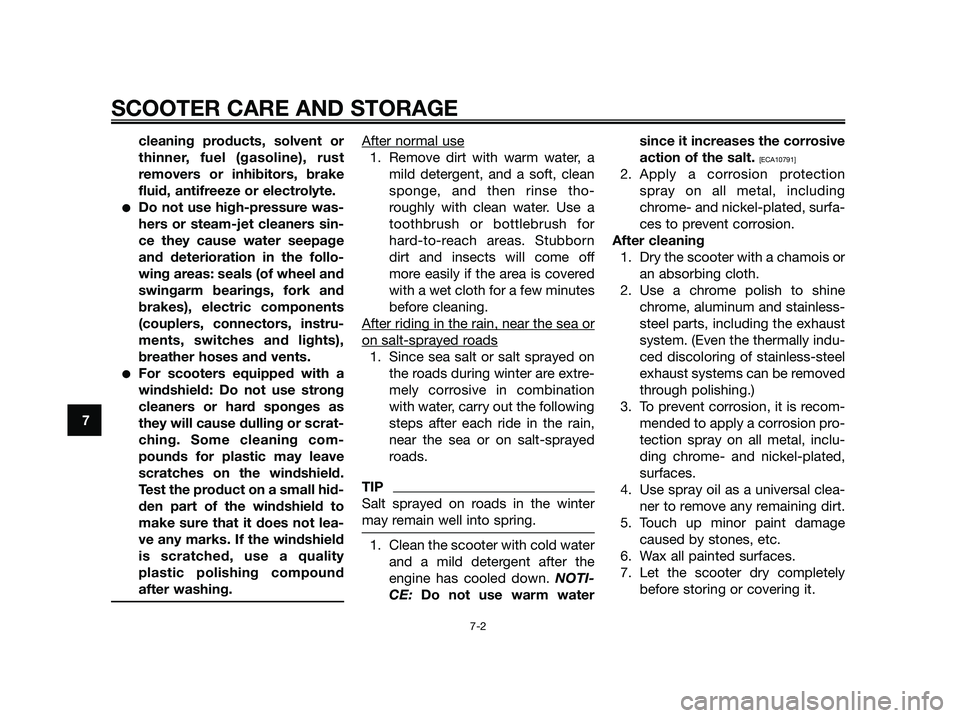
cleaning products, solvent or
thinner, fuel (gasoline), rust
removers or inhibitors, brake
fluid, antifreeze or electrolyte.
●Do not use high-pressure was-
hers or steam-jet cleaners sin-
ce they cause water seepage
and deterioration in the follo-
wing areas: seals (of wheel and
swingarm bearings, fork and
brakes), electric components
(couplers, connectors, instru-
ments, switches and lights),
breather hoses and vents.
●For scooters equipped with a
windshield: Do not use strong
cleaners or hard sponges as
they will cause dulling or scrat-
ching. Some cleaning com-
pounds for plastic may leave
scratches on the windshield.
Test the product on a small hid-
den part of the windshield to
make sure that it does not lea-
ve any marks. If the windshield
is scratched, use a quality
plastic polishing compound
after washing.
After normal use
1. Remove dirt with warm water, a
mild detergent, and a soft, clean
sponge, and then rinse tho-
roughly with clean water. Use a
toothbrush or bottlebrush for
hard-to-reach areas. Stubborn
dirt and insects will come off
more easily if the area is covered
with a wet cloth for a few minutes
before cleaning.
After riding in the rain, near the sea or
on salt-sprayed roads
1. Since sea salt or salt sprayed on
the roads during winter are extre-
mely corrosive in combination
with water, carry out the following
steps after each ride in the rain,
near the sea or on salt-sprayed
roads.
TIP
Salt sprayed on roads in the winter
may remain well into spring.
1. Clean the scooter with cold water
and a mild detergent after the
engine has cooled down. NOTI-
CE:Do not use warm watersince it increases the corrosive
action of the salt.
[ECA10791]
2. Apply a corrosion protection
spray on all metal, including
chrome- and nickel-plated, surfa-
ces to prevent corrosion.
After cleaning
1. Dry the scooter with a chamois or
an absorbing cloth.
2. Use a chrome polish to shine
chrome, aluminum and stainless-
steel parts, including the exhaust
system. (Even the thermally indu-
ced discoloring of stainless-steel
exhaust systems can be removed
through polishing.)
3. To prevent corrosion, it is recom-
mended to apply a corrosion pro-
tection spray on all metal, inclu-
ding chrome- and nickel-plated,
surfaces.
4. Use spray oil as a universal clea-
ner to remove any remaining dirt.
5. Touch up minor paint damage
caused by stones, etc.
6. Wax all painted surfaces.
7. Let the scooter dry completely
before storing or covering it.
SCOOTER CARE AND STORAGE
7-2
7
Page 68 of 76
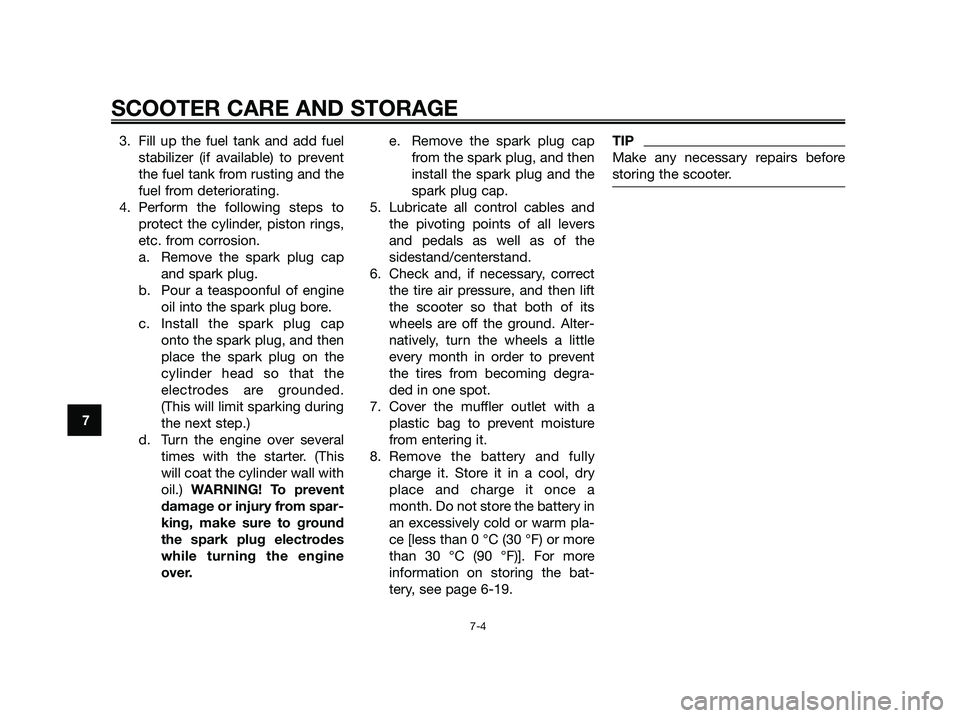
3. Fill up the fuel tank and add fuel
stabilizer (if available) to prevent
the fuel tank from rusting and the
fuel from deteriorating.
4. Perform the following steps to
protect the cylinder, piston rings,
etc. from corrosion.
a. Remove the spark plug cap
and spark plug.
b. Pour a teaspoonful of engine
oil into the spark plug bore.
c. Install the spark plug cap
onto the spark plug, and then
place the spark plug on the
cylinder head so that the
electrodes are grounded.
(This will limit sparking during
the next step.)
d. Turn the engine over several
times with the starter. (This
will coat the cylinder wall with
oil.) WARNING! To prevent
damage or injury from spar-
king, make sure to ground
the spark plug electrodes
while turning the engine
over. e. Remove the spark plug cap
from the spark plug, and then
install the spark plug and the
spark plug cap.
5. Lubricate all control cables and
the pivoting points of all levers
and pedals as well as of the
sidestand/centerstand.
6. Check and, if necessary, correct
the tire air pressure, and then lift
the scooter so that both of its
wheels are off the ground. Alter-
natively, turn the wheels a little
every month in order to prevent
the tires from becoming degra-
ded in one spot.
7. Cover the muffler outlet with a
plastic bag to prevent moisture
from entering it.
8. Remove the battery and fully
charge it. Store it in a cool, dry
place and charge it once a
month. Do not store the battery in
an excessively cold or warm pla-
ce [less than 0 °C (30 °F) or more
than 30 °C (90 °F)]. For more
information on storing the bat-
tery, see page 6-19.TIP
Make any necessary repairs before
storing the scooter.
SCOOTER CARE AND STORAGE
7-4
7